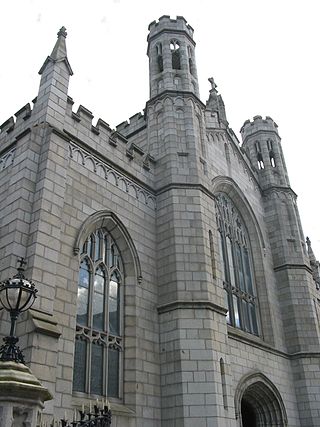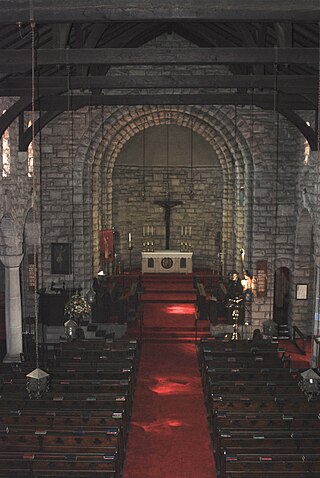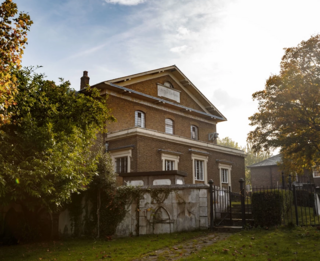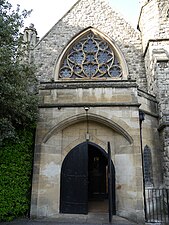
Kingston Vale with Kingston Hill is a district in the Royal Borough of Kingston upon Thames in south-west London. It is a residential area between Richmond Park, the much smaller Putney Vale, Wimbledon Common, Coombe/Coombe Hill and the Norbiton part of the very old borough. The main road is the A308 which is a through route for traffic passing to and from Kingston Hill to the A3 trunk road. Many of the branch roads are cul-de-sacs. It includes, toward the east and in the Vale, the only part of Kingston which drains eastward, that is, into Beverley Brook. The hill expanse, shared with Coombe and a golf course, has a hotel, some tall blocks overlooking Kingston, the edge of Kingston Hospital, the main campus of Kingston University London and faint remnants of dense woodland.

The Diocese of Southwark is one of the 42 dioceses of the Church of England, part of the worldwide Anglican Communion. The diocese forms part of the Province of Canterbury in England. It was created on 1 May 1905 from part of the ancient Diocese of Rochester that was served by a suffragan bishop of Southwark (1891–1905). Before 1877 most of the area was part of the Diocese of Winchester, some being part of the Diocese of London.

The Parish Church of St Margaret is a Church of England parish church situated on St Margaret's Road, off Bury Old Road (A665) in Prestwich, Greater Manchester, England. The Grade II listed church, in the Diocese of Manchester, was designed in the Decorated style by the Manchester architects Travis and Mangnall in 1849 as a chapel-of-ease to the ancient Prestwich Parish Church of St Mary the Virgin. Opened in 1851, it was extended in 1863, 1871, 1884, 1888 and 1899, and is notable for its fine Arts and Crafts wood carvings by Arthur Simpson of Kendal and late twentieth-century fittings. The church's daughter church of St George, Simister, is in the same parish.

St Cyprian's Church is a parish church of the Church of England in the Marylebone district of London. The church was consecrated in 1903, but the parish was founded in 1866. It is dedicated to Cyprian, a third-century martyr and bishop of Carthage and is near the Clarence Gate Gardens entrance to Regent's Park, off Baker Street. The present church was designed by Ninian Comper and is a Grade II* listed building.

St. Luke's and St. Margaret's Church is a former parish of the Episcopal Diocese of Massachusetts in the Allston neighborhood of Boston. It was closed in 2010.

St Luke's Church is an Anglican church in the Queen's Park area of Brighton, part of the English city of Brighton and Hove. Occupying a large corner site on Queen's Park Road, it was designed in the 1880s by Sir Arthur Blomfield in the Early English style, and has been given listed building status because of its architectural importance.

Saint Mary at Stoke is a Grade I listed Anglican church in the Old Stoke area of Ipswich.

The Cathedral of Saint Patrick and Saint Colman or Newry Cathedral is a Roman Catholic cathedral located in Newry, Northern Ireland. It acts as the seat of the Bishop of Dromore, and the Mother church of the Roman Catholic Diocese of Dromore. Prior to the COVID-19 pandemic, over 200,000 people visited the cathedral each year. The cathedral sits on Newry's Main Street and is a Grade A listed building.

St Boniface Church is the mother church of the Anglican parish of Germiston, Gauteng which also includes the chapelries of St Mary and St John in Lambton, and St Mark in Rosedeep. The parish is part of the Diocese of the Highveld, which is in turn part of the Anglican Church of Southern Africa.

The Barn Church, Kew, formally known as St Philip and All Saints, is the first barn church to be consecrated in England. The building, which is not listed, is on the corner of Atwood Avenue and Marksbury Avenue, in an area previously known as North Sheen and now in Kew, in the London Borough of Richmond upon Thames. It was constructed in 1929 from a 17th century barn from Oxted in Surrey. The west end was converted in 2002 into a large parish room with a gallery above looking down the length of the building. The sanctuary was refurbished and remodelled in 1998.

St. Alban's Church, Swaythling, Southampton, stands on Tulip Road, just off the main Burgess Road. The church, and its associated hall, is a Grade II listed building.

St John the Divine, Richmond, in the Anglican Diocese of Southwark, is a Grade II listed church on Kew Road, in Richmond, London, near Richmond railway station. Built in 1836, and a parish in its own right since 1838, it was designed by Lewis Vulliamy in the Early Gothic Revival architectural style.

St Andrew's Brighton is the oldest continuous Anglican church in Victoria, Australia. St Andrew's is the Anglican parish church of the beachside suburb of Brighton, Melbourne.

St Peter's Church, Ealing, is an Anglican parish church in Mount Park Road, North Ealing, in the Diocese of London, regarded by Sir John Betjeman a church "of which we can justafiably be proud. Held to be one of the premier architectural works in Ealing, the Grade II* Listed building is noted for its combination of Arts & Crafts and late-Victorian Gothic as well as its west front and great west window. In addition to Sunday and weekday services, the church and adjacent hall serve as a hub for various community activities and events.

William Allen Dixon (1821–1893) was a British architect who specialised in the design of churches and particularly Baptist churches. His heyday was in the late 1860s to the early 1870s when he designed at least five church in England, several of which are grade II listed buildings.

Alexander Angus Croll (1811-1887) was a British civil engineer who patented a method of purifying town gas of ammonia. He was Sheriff of the City of London.

The Roman Catholic Church of Saint Charles Borromeo is a Roman Catholic church on Ogle Street in the Diocese of Westminster, London.

St Peter's Church is a Catholic church in Woolwich, South East London. It is situated between Woolwich New Road and Brookhill Road, the main entrance being on Woolwich New Road. The church was designed by Augustus Pugin in 1841–42 in the style of the Gothic Revival and is one of only three Pugin churches in London. Pugin's design remained unfinished as the projected tower and spire were never built. The parish of St Peter the Apostle serves the Catholic community of central Woolwich and surrounding areas, and is part of the Archdiocese of Southwark which is in the Province of Southwark.

St Paul's Church is a Church of England parish church in Clapham, London. There has been a church on the site since the 12th century. The current building was completed in 1815 and is Grade II* listed. In the grounds, which hold the Green Flag Award, are some fine tombs including many early 19th century sarcophagi and a community garden, Eden. The incumbent is Revd Canon Jonathan Boardman.
St Mary the Virgin Church is a parish church in Welling in the London Borough of Bexley. It is dedicated to the Virgin Mary. The church is in the Archdeaconry of Lewisham & Greenwich, in the Diocese of Southwark. It is notable for the range of 20th-century art contained within it.

























